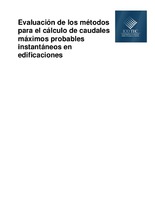Mostrar el registro sencillo del ítem
Evaluación de los Métodos para el Cálculo de Caudales Máximos Probables instantáneos en Edificaciones
| dc.contributor.advisor | Araya, Andrés | es |
| dc.contributor.author | Zamora-Álvarez, Renán Alonso | |
| dc.date.accessioned | 2015-08-20T15:19:08Z | |
| dc.date.available | 2015-08-20T15:19:08Z | |
| dc.date.issued | 2013 | |
| dc.identifier.uri | https://hdl.handle.net/2238/6203 | |
| dc.description | Proyecto de Graduación (Licenciatura en Ingeniería en Construcción).Instituto Tecnológico de Costa Rica. Escuela de Ingeniería en Construcción, 2013. | es |
| dc.description.abstract | The design methodologies of the probable max flow in buildings is based on empirical, half empirical and probabilistic subsistence, most of them estimated long time ago with high intake health hardware, what makes its implementation today involve in most of the cases an over estimation of the estimated volume making more expensive the designs of the internal edifications. The present work evaluated eight theoretical methods which contrasted with the probable max caudal graduated in four buildings using a Innova Sonic 210-I ultrasonic flow measurer. The research contemplates the measurements of volume of an offices building, a school, an apartment building, and in a house-room. In addition, is made a comparison of the intake reported for the health hardware in the theoretical models and the gauging done on each one of the hardware installed on the edifications. It was obtained that the French Norm and Hunter Colombia methods are the ones who generated the closest values graduated on an error percentage of 6.9% and 5.5% in the case of Hunter Colombia for the school and the apartment building respectively and a 5.9% and 15.5% for the houseroom and the offices building reported by the French Norm. The health hardware that are actually on the market differ on the spending values in liters/ second, respect to the normed values in the theoretical methodologies, with a mistake percent that goes from the 30% to a 75% average. This research is a base for cementing the future investigations that allow the compilation of enough information to obtain more general results respect to the max probable flow and the variation on the time demand. | es |
| dc.description.sponsorship | Instituto Tecnológico de Costa Rica. Escuela de Ingeniería en Construcción. | es |
| dc.language.iso | es | es |
| dc.publisher | Instituto Tecnológico de Costa Rica | es |
| dc.rights | acceso abierto | es |
| dc.subject | Mediciones | es |
| dc.subject | Racional | es |
| dc.subject | Métodos probabilisticos | es |
| dc.subject | Consumo de agua | es |
| dc.subject | Métodos de diseño | es |
| dc.title | Evaluación de los Métodos para el Cálculo de Caudales Máximos Probables instantáneos en Edificaciones | es |
| dc.type | proyecto fin de carrera | es |


